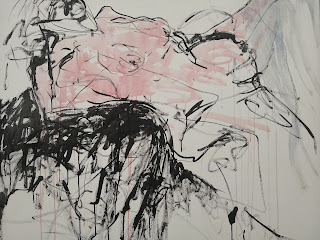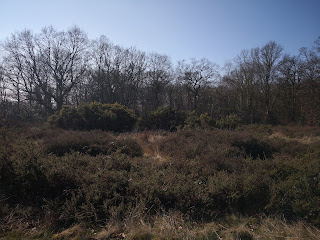Never mind Tracey Emin's unmade bed. Instead, have a look at the turmoil that is her mind. On the surface, that's a far messier place. But that would be too pat a take on Emin's art and, specifically, her fairly large new exhibition in Bermondsey's White Cube gallery, a Fortnight of Tears. Yes, Emin has her demons, her regrets, and a fair bit of history - but don't we all? Those who don't, it could be argued, haven't really lived.
Where Emin differs from most of us is that instead of piling it all up beneath the emotional carpet she's laid it all bare for us to see. She's both picking her scabs and allowing us to watch (and even join in) as she does so. Using the mediums of photography, painting, sculpture, film, and even poetry Emin has eviscerated her soul for her art and, in doing so, has attempted to exorcise the demons that lurk within. Demons that, in her particular case, relate to rape, abortion, bereavement, and insomnia. An insomnia that, very likely, comes from thinking about those first three things.
The Memory of tears (2018)
You may not like Emin's art (her reputation precedes her) but you can't say she doesn't mean it, you can't say she's afraid to touch on the big subjects, and you can't say she's not prepared to work hard (and suffer for it).
She can draw a bit too but we have to wait for that. This show, following the poem I headed up this blog with (one that must speak to anyone who's laid awake at night wishing they could turn their brain off), kicks off with a room full of photographs. Selfies of Tracey taken when she's been unable to sleep. No make up, bags under the eyes, blown up to twice the actual size of her head. It's hardly an exercise in image control. More an opening gambit that says "this is me. Take it or leave it".
Insomnia Room Installation (2018)
Insomnia Room Installation (2018)
Insomnia Room Installation (2018)
Insomnia Room Installation (2018)
I took it. I was glad I did. This was a show that improved the more time one spent with it, much like most people do. If you make quick and easy judgements on either people or art you're most likely missing out on a lot of important stuff, and important stuff is what Tracey Emin is all about.
There's technical ability in her scratchy, impressionistic, expressionistic paintings and drawings but, more than that, there's passion. If her unorthodox appropriation of capital letters initially jars a touch, it soon seems to fit with her slightly skewed, yet somewhat romantic, worldview. The titles alone ('You kept watching me', 'And There was Love', 'There was a time when I only Thought of you') speak of a mind, a body even, consumed by passion, desire, regret, and, most of all, love.
There's technical ability in her scratchy, impressionistic, expressionistic paintings and drawings but, more than that, there's passion. If her unorthodox appropriation of capital letters initially jars a touch, it soon seems to fit with her slightly skewed, yet somewhat romantic, worldview. The titles alone ('You kept watching me', 'And There was Love', 'There was a time when I only Thought of you') speak of a mind, a body even, consumed by passion, desire, regret, and, most of all, love.
You kept watching me (2018)
There was a time when I only Thought of you (2018)
The Picnic (2018)
A Fortnight of Tears (2018)
Apparition (2018)
No Love (2018)
And There was Love (2018)
Whilst both decisions made in love and decisions in anger can backfire on us, those made in love should never be regretted in the same way. Tracey Emin's art seems to be the art of a person who'd rather bleed herself dry than injure anyone else. She's in her fifties now but there's something splendidly childlike in both her drawings as well as exhortations such as "NOT TO LOVE THE PERSON YOU ARE WITH IS A CRIME' rendered as if spray painted on a garage door, even the drips imbue it with a deep authenticity.
They have the overt and vulnerable sexuality of an Egon Schiele (without the appropriation and male gaze we've come to associate with that particular artist) but they're mixed with the frank emotional trauma of a Munch or a Van Gogh.
High praise indeed but, I think, deserved and it seems those who curate Oslo's Museum Island agree as one of Emin's sculptures is to be permanently installed there from spring 2020. These sculptures, I'm about the size of one of the legs, are both monumental but also very human. There's something of the Lucian Freud in the way Emin works base materials into a fair approximation of flesh and then beyond into intimations of desire, lust, and motherhood. Alternately, you could view them as Giacomettis who have stopped marching in tune to the diktats of fashion and embraced their real bodies.
The Mother (2017)
Angel (2017)
While the sculptures are, for the most part, celebrations of the human, specifically female, body and the works that flank the corridors are mostly about love and sex - there are other works here that come, quite clearly, from a place of heartbreak. Two large side rooms are given over to these and one has been renamed The Ashes Room and is being used to house the works Emin made following the death of her mother, Pam, in 2016.
There are vitrines containing intimate, and personal, paper works as well as memorabilia and these are worthy additions to the show, but most powerful of all are pieces like I Could Feel You and Mum. Mum is an intentionally naive purple drawing of a lady watching TV under the slogan "Another day of Summer without you" and I Could Feel You sees perhaps the same lady, Emin's mum?, prepare to take the wooden hill to Bedfordshire for what, we must sadly assume, will be the last time.
I Could Feel You (2018)
Mum (2018)
I watched you disappear, Pink Ghost (2018)
I was too young to be carrying your Ashes (2017-18)
Whilst death is the end for the dead, that's not the case for those that are left behind and Emin has worked up spectral pink and blood red apparitions of herself in mourning, in one instance carrying a box of her mother's ashes. An unbearably sad image to ponder. One wonders if it was cathartic to paint? Or just plain difficult?
The fact that Emin has never shied away from tough subject matter can't have made it much easier. I'm not sure anything much can prepare you for the death of a loved one. If I'd been wearing a hat I'd have removed it in respect. Instead I headed to the huge South Gallery II and was confronted with further sadness. This time of a quite violent and visceral nature.
I am The Last Person (2018)
I sent kisses That came back to me (2016)
Every Part of me kept Loving you (2016)
I made you Happen (2018)
The Abortion Waiting Room 1990 (2018)
Titles like 'The Abortion Waiting Room 1990' and 'They Held me down while Fucked me 1976' don't leave you in much doubt as to what they're about - and as this is Emin we can be pretty certain she's speaking from personal experience. Any life looked back on will contain more than its fair share of horror, injustice, and regret but Emin's work makes it patently clear that for women this can be exponential.
Emin isn't a feminist artist per se but it'd be as difficult for images that painfully show the results of toxic masculinity and how females are often dealt a subservient role in our society not to carry both a poignant and, hopefully, empowering message. As a heterosexual man it would be crass of me to claim I could possibly fully understand a lived experience that I have never, and will never, have.
So instead I marvel at just how much power she can invoke with these simple, often just three colours, acrylics on canvas. How much life permeates her work as surely as the ever present threat of death. Both one's own and one's loved ones - and that's why, I think, she's so good. Because while we're alive both life, and that threat of death, are always with us. Again, I wanted to turn my brain off, just for a bit.
They Held me down while he Fucked me 1976 (2018)
And So It Felt Like This (2018)
Mum & Dad (2017)
In The Dead Dark of night I wanted you (2018)
The last thing I saw before leaving was Emin's 1996 short film 'How it Feels' in which she revisits the area around the surgery where her abortion was carried out. She explains in frank, sometimes upsetting, detail about the events that led up to it, the procedure itself, and the aftermath. There was a warning on the door as I entered that graphic medical detail would be given and being more than a bit squeamish I considered leaving before we got to that bit (some, I noticed, did) but I'm glad I didn't. As a man I may be a bit 'funny' about some of the workings of the female body but as I'm happy to sexualise female bodies perhaps I ought to try to understand them a bit more.
As it turned out, it wasn't a biology lesson I got though but a lesson in listening. One I was even more in need of! As Emin explained the very peculiar and very particular circumstances of this event in her life (and explained all the various emotions that were rushing around her head at that time) I realised how easy it is to judge, how easy it is to succumb to confirmation bias, and how difficult it can be to listen. When you listen you often realise people's lives are far more nuanced, far more complicated, than they seem from afar.
As with art, to get up close is to see a different picture entirely. Emin bravely allows us to do this. Others are more protective. It doesn't mean we shouldn't try to make connections because without those connections we're all on our own in a terrifying, frightening (and, indeed, beautiful and fantastic) world. Life's a journey and, like most journeys, it's vastly improved by a fellow traveller. On Wednesday afternoon I was happy to share my metaphorical motor with Tracey Emin.
When I Sleep (2018)
I Longed For You (2019)

























































































































